Chunyi Zhou
Poison in the Well: Feature Embedding Disruption in Backdoor Attacks
May 26, 2025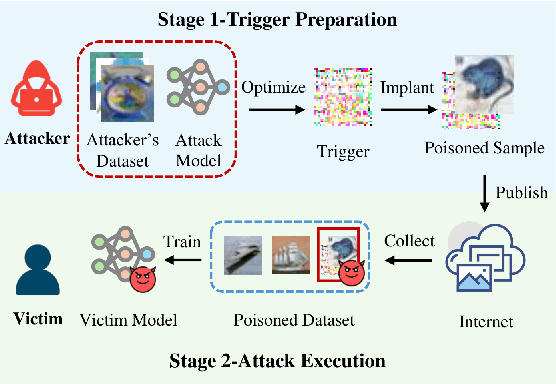
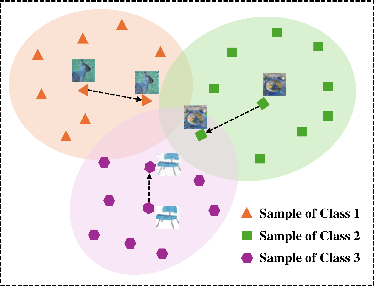
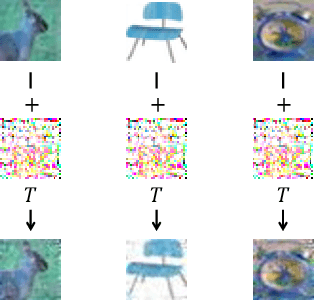

Abstract:Backdoor attacks embed malicious triggers into training data, enabling attackers to manipulate neural network behavior during inference while maintaining high accuracy on benign inputs. However, existing backdoor attacks face limitations manifesting in excessive reliance on training data, poor stealth, and instability, which hinder their effectiveness in real-world applications. Therefore, this paper introduces ShadowPrint, a versatile backdoor attack that targets feature embeddings within neural networks to achieve high ASRs and stealthiness. Unlike traditional approaches, ShadowPrint reduces reliance on training data access and operates effectively with exceedingly low poison rates (as low as 0.01%). It leverages a clustering-based optimization strategy to align feature embeddings, ensuring robust performance across diverse scenarios while maintaining stability and stealth. Extensive evaluations demonstrate that ShadowPrint achieves superior ASR (up to 100%), steady CA (with decay no more than 1% in most cases), and low DDR (averaging below 5%) across both clean-label and dirty-label settings, and with poison rates ranging from as low as 0.01% to 0.05%, setting a new standard for backdoor attack capabilities and emphasizing the need for advanced defense strategies focused on feature space manipulations.
UNIDOOR: A Universal Framework for Action-Level Backdoor Attacks in Deep Reinforcement Learning
Jan 26, 2025



Abstract:Deep reinforcement learning (DRL) is widely applied to safety-critical decision-making scenarios. However, DRL is vulnerable to backdoor attacks, especially action-level backdoors, which pose significant threats through precise manipulation and flexible activation, risking outcomes like vehicle collisions or drone crashes. The key distinction of action-level backdoors lies in the utilization of the backdoor reward function to associate triggers with target actions. Nevertheless, existing studies typically rely on backdoor reward functions with fixed values or conditional flipping, which lack universality across diverse DRL tasks and backdoor designs, resulting in fluctuations or even failure in practice. This paper proposes the first universal action-level backdoor attack framework, called UNIDOOR, which enables adaptive exploration of backdoor reward functions through performance monitoring, eliminating the reliance on expert knowledge and grid search. We highlight that action tampering serves as a crucial component of action-level backdoor attacks in continuous action scenarios, as it addresses attack failures caused by low-frequency target actions. Extensive evaluations demonstrate that UNIDOOR significantly enhances the attack performance of action-level backdoors, showcasing its universality across diverse attack scenarios, including single/multiple agents, single/multiple backdoors, discrete/continuous action spaces, and sparse/dense reward signals. Furthermore, visualization results encompassing state distribution, neuron activation, and animations demonstrate the stealthiness of UNIDOOR. The source code of UNIDOOR can be found at https://github.com/maoubo/UNIDOOR.
Navigating the Risks: A Survey of Security, Privacy, and Ethics Threats in LLM-Based Agents
Nov 14, 2024



Abstract:With the continuous development of large language models (LLMs), transformer-based models have made groundbreaking advances in numerous natural language processing (NLP) tasks, leading to the emergence of a series of agents that use LLMs as their control hub. While LLMs have achieved success in various tasks, they face numerous security and privacy threats, which become even more severe in the agent scenarios. To enhance the reliability of LLM-based applications, a range of research has emerged to assess and mitigate these risks from different perspectives. To help researchers gain a comprehensive understanding of various risks, this survey collects and analyzes the different threats faced by these agents. To address the challenges posed by previous taxonomies in handling cross-module and cross-stage threats, we propose a novel taxonomy framework based on the sources and impacts. Additionally, we identify six key features of LLM-based agents, based on which we summarize the current research progress and analyze their limitations. Subsequently, we select four representative agents as case studies to analyze the risks they may face in practical use. Finally, based on the aforementioned analyses, we propose future research directions from the perspectives of data, methodology, and policy, respectively.
Intellectual Property Protection for Deep Learning Model and Dataset Intelligence
Nov 07, 2024
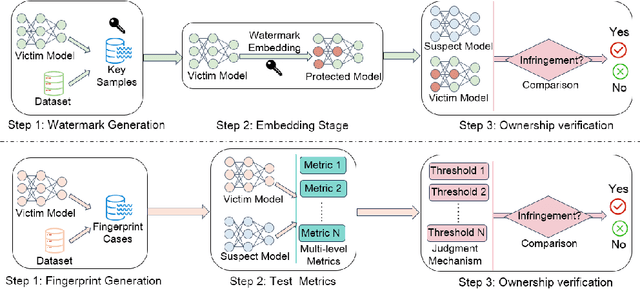


Abstract:With the growing applications of Deep Learning (DL), especially recent spectacular achievements of Large Language Models (LLMs) such as ChatGPT and LLaMA, the commercial significance of these remarkable models has soared. However, acquiring well-trained models is costly and resource-intensive. It requires a considerable high-quality dataset, substantial investment in dedicated architecture design, expensive computational resources, and efforts to develop technical expertise. Consequently, safeguarding the Intellectual Property (IP) of well-trained models is attracting increasing attention. In contrast to existing surveys overwhelmingly focusing on model IPP mainly, this survey not only encompasses the protection on model level intelligence but also valuable dataset intelligence. Firstly, according to the requirements for effective IPP design, this work systematically summarizes the general and scheme-specific performance evaluation metrics. Secondly, from proactive IP infringement prevention and reactive IP ownership verification perspectives, it comprehensively investigates and analyzes the existing IPP methods for both dataset and model intelligence. Additionally, from the standpoint of training settings, it delves into the unique challenges that distributed settings pose to IPP compared to centralized settings. Furthermore, this work examines various attacks faced by deep IPP techniques. Finally, we outline prospects for promising future directions that may act as a guide for innovative research.
"No Matter What You Do!": Mitigating Backdoor Attacks in Graph Neural Networks
Oct 02, 2024



Abstract:Recent studies have exposed that GNNs are vulnerable to several adversarial attacks, among which backdoor attack is one of the toughest. Similar to Deep Neural Networks (DNNs), backdoor attacks in GNNs lie in the fact that the attacker modifies a portion of graph data by embedding triggers and enforces the model to learn the trigger feature during the model training process. Despite the massive prior backdoor defense works on DNNs, defending against backdoor attacks in GNNs is largely unexplored, severely hindering the widespread application of GNNs in real-world tasks. To bridge this gap, we present GCleaner, the first backdoor mitigation method on GNNs. GCleaner can mitigate the presence of the backdoor logic within backdoored GNNs by reversing the backdoor learning procedure, aiming to restore the model performance to a level similar to that is directly trained on the original clean dataset. To achieve this objective, we ask: How to recover universal and hard backdoor triggers in GNNs? How to unlearn the backdoor trigger feature while maintaining the model performance? We conduct the graph trigger recovery via the explanation method to identify optimal trigger locations, facilitating the search of universal and hard backdoor triggers in the feature space of the backdoored model through maximal similarity. Subsequently, we introduce the backdoor unlearning mechanism, which combines knowledge distillation and gradient-based explainable knowledge for fine-grained backdoor erasure. Extensive experimental evaluations on four benchmark datasets demonstrate that GCleaner can reduce the backdoor attack success rate to 10% with only 1% of clean data, and has almost negligible degradation in model performance, which far outperforms the state-of-the-art (SOTA) defense methods.
TruVRF: Towards Triple-Granularity Verification on Machine Unlearning
Aug 12, 2024Abstract:The concept of the right to be forgotten has led to growing interest in machine unlearning, but reliable validation methods are lacking, creating opportunities for dishonest model providers to mislead data contributors. Traditional invasive methods like backdoor injection are not feasible for legacy data. To address this, we introduce TruVRF, a non-invasive unlearning verification framework operating at class-, volume-, and sample-level granularities. TruVRF includes three Unlearning-Metrics designed to detect different types of dishonest servers: Neglecting, Lazy, and Deceiving. Unlearning-Metric-I checks class alignment, Unlearning-Metric-II verifies sample count, and Unlearning-Metric-III confirms specific sample deletion. Evaluations on three datasets show TruVRF's robust performance, with over 90% accuracy for Metrics I and III, and a 4.8% to 8.2% inference deviation for Metric II. TruVRF also demonstrates generalizability and practicality across various conditions and with state-of-the-art unlearning frameworks like SISA and Amnesiac Unlearning.
Decaf: Data Distribution Decompose Attack against Federated Learning
May 24, 2024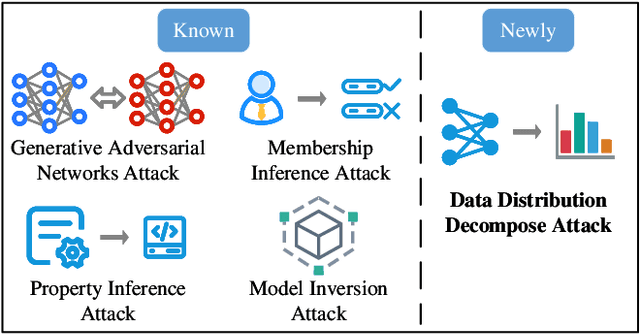
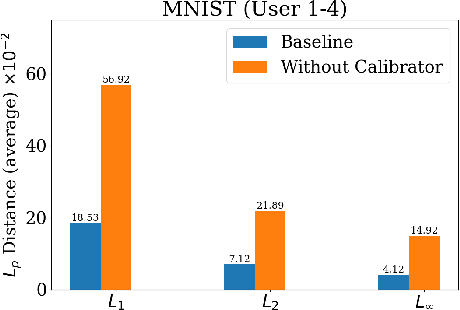

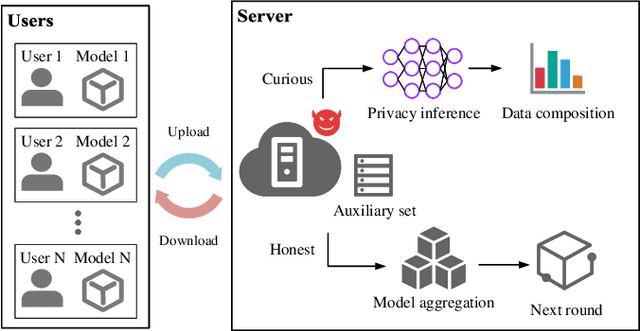
Abstract:In contrast to prevalent Federated Learning (FL) privacy inference techniques such as generative adversarial networks attacks, membership inference attacks, property inference attacks, and model inversion attacks, we devise an innovative privacy threat: the Data Distribution Decompose Attack on FL, termed Decaf. This attack enables an honest-but-curious FL server to meticulously profile the proportion of each class owned by the victim FL user, divulging sensitive information like local market item distribution and business competitiveness. The crux of Decaf lies in the profound observation that the magnitude of local model gradient changes closely mirrors the underlying data distribution, including the proportion of each class. Decaf addresses two crucial challenges: accurately identify the missing/null class(es) given by any victim user as a premise and then quantify the precise relationship between gradient changes and each remaining non-null class. Notably, Decaf operates stealthily, rendering it entirely passive and undetectable to victim users regarding the infringement of their data distribution privacy. Experimental validation on five benchmark datasets (MNIST, FASHION-MNIST, CIFAR-10, FER-2013, and SkinCancer) employing diverse model architectures, including customized convolutional networks, standardized VGG16, and ResNet18, demonstrates Decaf's efficacy. Results indicate its ability to accurately decompose local user data distribution, regardless of whether it is IID or non-IID distributed. Specifically, the dissimilarity measured using $L_{\infty}$ distance between the distribution decomposed by Decaf and ground truth is consistently below 5\% when no null classes exist. Moreover, Decaf achieves 100\% accuracy in determining any victim user's null classes, validated through formal proof.
Machine Unlearning: Taxonomy, Metrics, Applications, Challenges, and Prospects
Mar 13, 2024Abstract:Personal digital data is a critical asset, and governments worldwide have enforced laws and regulations to protect data privacy. Data users have been endowed with the right to be forgotten of their data. In the course of machine learning (ML), the forgotten right requires a model provider to delete user data and its subsequent impact on ML models upon user requests. Machine unlearning emerges to address this, which has garnered ever-increasing attention from both industry and academia. While the area has developed rapidly, there is a lack of comprehensive surveys to capture the latest advancements. Recognizing this shortage, we conduct an extensive exploration to map the landscape of machine unlearning including the (fine-grained) taxonomy of unlearning algorithms under centralized and distributed settings, debate on approximate unlearning, verification and evaluation metrics, challenges and solutions for unlearning under different applications, as well as attacks targeting machine unlearning. The survey concludes by outlining potential directions for future research, hoping to serve as a guide for interested scholars.
PPA: Preference Profiling Attack Against Federated Learning
Feb 10, 2022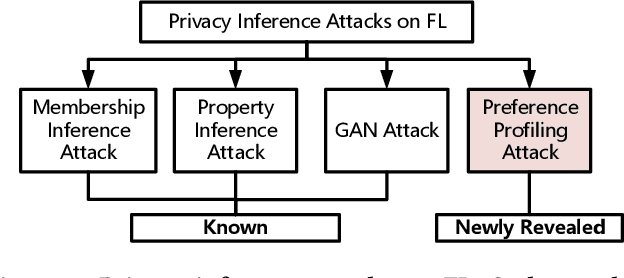
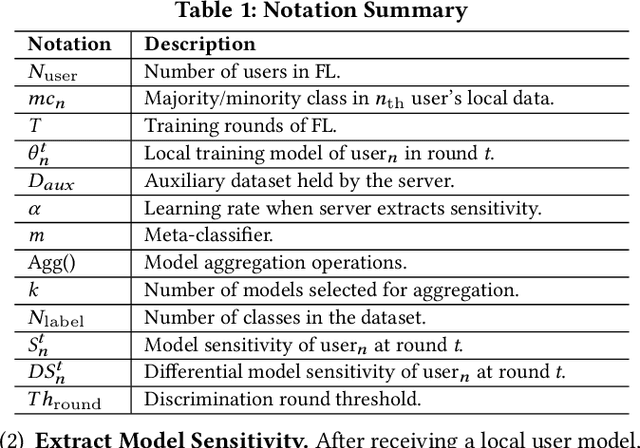
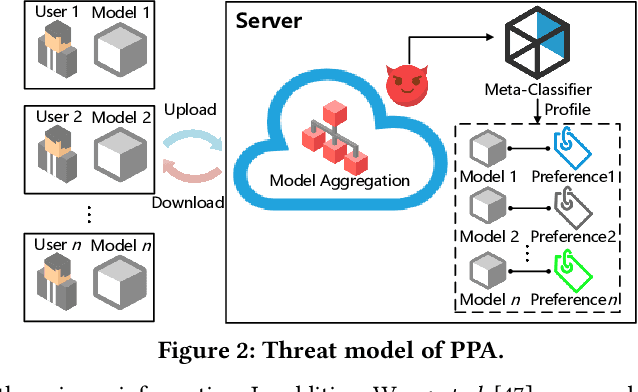

Abstract:Federated learning (FL) trains a global model across a number of decentralized participants, each with a local dataset. Compared to traditional centralized learning, FL does not require direct local datasets access and thus mitigates data security and privacy concerns. However, data privacy concerns for FL still exist due to inference attacks, including known membership inference, property inference, and data inversion. In this work, we reveal a new type of privacy inference attack, coined Preference Profiling Attack (PPA), that accurately profiles private preferences of a local user. In general, the PPA can profile top-k, especially for top-1, preferences contingent on the local user's characteristics. Our key insight is that the gradient variation of a local user's model has a distinguishable sensitivity to the sample proportion of a given class, especially the majority/minority class. By observing a user model's gradient sensitivity to a class, the PPA can profile the sample proportion of the class in the user's local dataset and thus the user's preference of the class is exposed. The inherent statistical heterogeneity of FL further facilitates the PPA. We have extensively evaluated the PPA's effectiveness using four datasets from the image domains of MNIST, CIFAR10, Products-10K and RAF-DB. Our results show that the PPA achieves 90% and 98% top-1 attack accuracy to the MNIST and CIFAR10, respectively. More importantly, in the real-world commercial scenarios of shopping (i.e., Products-10K) and the social network (i.e., RAF-DB), the PPA gains a top-1 attack accuracy of 78% in the former case to infer the most ordered items, and 88% in the latter case to infer a victim user's emotions. Although existing countermeasures such as dropout and differential privacy protection can lower the PPA's accuracy to some extent, they unavoidably incur notable global model deterioration.
 Add to Chrome
Add to Chrome Add to Firefox
Add to Firefox Add to Edge
Add to Edge